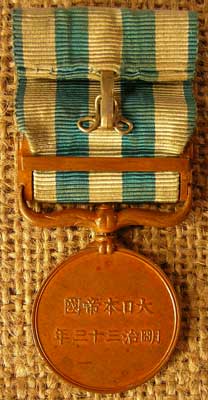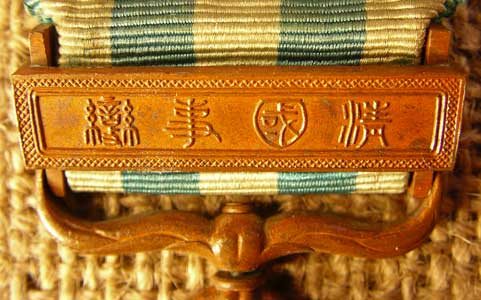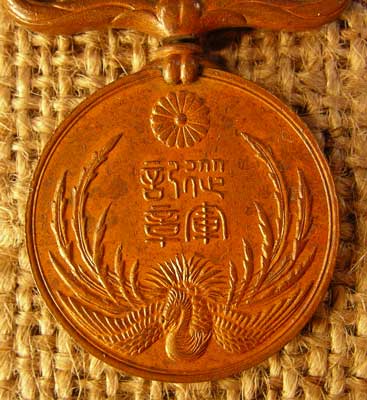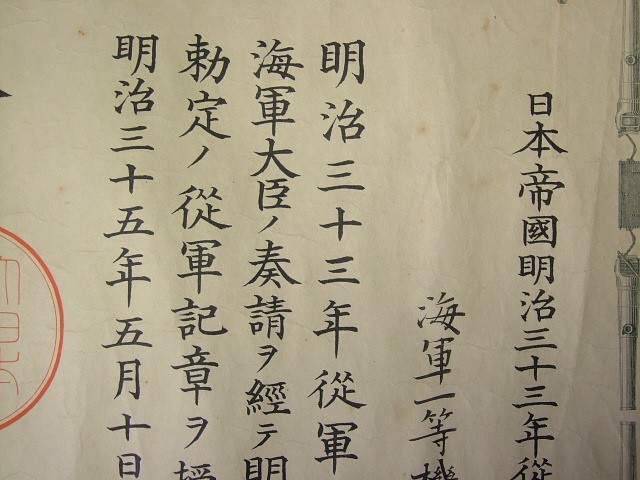Nambu World: Boxer Rebellion (Relief of

In the late
1800s anti-foreign sentiment in
Here is the back of the medal, showing the usual type of clasp found on Japanese medals.

The bar has
four old-style characters that are read from right to left: shin-koku-ji-hen, meaning “China
Incident”. Note that the characters used for

The four characters on the front are read top right-bottom right-top left-bottom left: ju-gun-ki-sho, or “medal for serving in the military”. The medal is 30mm (1-3/16”) in diameter.

The back reads from right to left. The top line is: dai-nip-pon-tei-koku (Great Japanese Empire). The bottom line is Mei-ji-san-ju-san-nen, Meiji 33, i.e. the 33rd year of the reign of the Meiji Emperor, which was 1900 according to the Western calendar.

Here is the medal in its case. The top of the case is missing and the right edge has been broken off.

I got the
medal in an auction which featured a Boxer Rebellion certificate at the same
time. I won the medal, but not the certificate. However, I did get this picture
of the certificate, which I think was probably the one that came with my
specific medal (i.e. I think the same individual probably received both, since
the chances of these two rare items coming up at the same time otherwise are
slim). The two large black characters in the upper centre of the certificate
say ho-choku, i.e “service to the
Emperor”. The certificate was awarded to a man with the surname (family name)
Ejiri. His given name could be pronounced either Kahei or Kahyoe. He was an kai-gun-it-to ki-kan-hei, i.e. first
class naval stoker/fireman (guy who fed coal into the engines of a naval ship ). This was certificate 11092. The left side has the
names of officials in the Board of Decorations. The far left column has the
name and stamp of
Secretary Zengen Fujii (family name Fujii). The second column
from the left has the name of another secretary of the Board, Kanae Yokota
(family name Yokota). The line immediately to the left of the big round red
Greater Japanese Empire stamp in the middle is the name and stamp of the
President (so-sai) of the Board of
Decorations (sho-kun-kyoku). He
was a shishaku (viscount). His
surname has over a dozen possible pronunciations, most likely Daikyu or Okyu.
His given name also has several possible pronunciations: Tsune, Hisashi,
Hitoshi and Wataru, for example. Since he was a big shot, I may eventually be
able to look him up in a Who’s Who-type directory in

The certificate was issued on May 10, Meiji 35 (1902).
 a
a
Here is a close-up of the artwork at the bottom centre.

If you would like to know more about the Boxer Rebellion, I recommend Peking 1900: The Boxer Rebellion, an Osprey publication by Peter Harrington, for a readable summary of the conflict.
To
return to the base page on Medals, please click here: Nambu
World: Japanese Medals
To return to “Other Japanese
Militaria”, please click here: Nambu
World: Other Japanese Militaria
To return to the home page, please
click here: Nambu World: Teri’s WWII Japanese
Handgun Website
Last updated: July 20, 2006. All contents are copyright Teri unless
otherwise specified and may not be used elsewhere in any form without prior
permission.